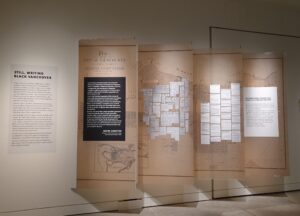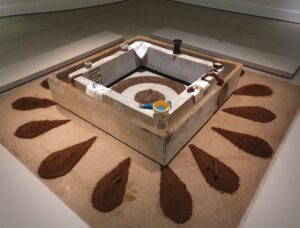By: Sara Wong, Arts & Culture Editor
“A past confronted with our future in mind.” That message, spelt in giant black vinyl letters, was the last thing I saw when I toured the Museum of Anthropology’s latest exhibit, Sankofa: African Routes, Canadian Roots. Weeks later, the phrase has stuck with me. It perfectly encapsulated the meaning of sankofa, which is “the notion that taking pride in heritage helps us to move into the future.”
Exploring trade, religion, and identity politics, Sankofa told a story of resilience and diversity in diaspora. Traditional and contemporary elements were interwoven throughout each section of the exhibit, driving home the idea that moving forward requires acknowledgement of the past. To me, this was most apparent in a series of wall hangings titled “Still, Writing Black Vancouver.” With a historical map of the city as the background, the wall hangings compared newspaper headlines concerning Black Canadians from around the 1940s to present day.
While the older headlines contained derogatory language, they depicted pivotal social justice movements in Metro Vancouver. The more current headlines carried the same tone, with descriptions of Black Lives Matter protests and calls to further recognize local Black community members like Harry Jerome and Barbara Howard.

SFU was also mentioned twice, the titles reading “Stand with SOCA and resist institutional racism at SFU” (2018) and “SFU commits to hiring, retaining at least 15 more Black faculty members” (2021). Aside from the SFU connection, these two headlines stood out to me because they highlighted the underlying message of the piece: there’s more work to be done when it comes to amplifying Black voices.
Going through Sankofa on my own was fascinating, but getting to hear from the curators made the visit much more eye-opening. As Nya Lewis took the lead, I found myself continuously drawn to the exhibit’s larger installations — specifically the room full of souvenir spoons and the multi-layered altar.
Discussing the spoons first, Lewis explained that while they’re all painted black, up close you can see the original silver, copper, and pewter finishes on some of them. Additionally, when you stand farther back, you don’t see the detailed designs of the spoons as much. This represents the constant changes in public perception Black Canadians face. And, according to Lewis, it’s “about searching or looking for Black histories as a Black person that is displaced or within diaspora.”
Meanwhile, the altar represented a community forging their own spiritual path, using found or familiar objects from present day to connect with their culture. “Some of us do not have access to our family trees, because that is what slavery does,” Lewis said. “Here we have this place where we’re just saying Blackness is possibility [ . . . ] We can decide what sankofa means. We can decide where we fit.”

In her closing remarks, Lewis said she “wanted the philosophies of sankofa to be grounded in something everybody could get into or understand.” The longer I spent inside the exhibit, the more that resonated with me. I can’t directly relate to the experiences shown in Sankofa, but identity politics is a familiar presence in my life. To this day, I hear comments that I’m “not Asian enough” or “look Chinese, but not at the same time.” While those remarks have stung from time to time, I’ve always been proud of my Chinese Canadian heritage. It’s where I fit.
Walking into this exhibit about African and Black Canadians, I did not expect to connect with the material so personally. But that is the power of Sankofa.








